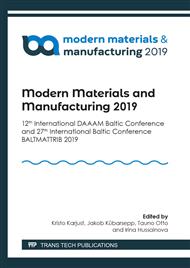[1]
F.E. Kennedy, P.J. Blau, Glossary, in: B. Bhushan (Ed.), Modern Tribology Handbook, CRC Press, London, 2001, pp.1645-1659.
Google Scholar
[2]
K. Kato, Wear in relation to friction - a review, Wear 241 (2000) 151-157.
DOI: 10.1016/s0043-1648(00)00382-3
Google Scholar
[3]
S. Leroch, M. Varga, S.J. Eder, A. Vernes, M. Rodriguez Ripoll, G. Ganzenmüller, Smooth particle hydrodynamics simulation of damage induced by a spherical indenter scratching a viscoplastic material, Int. J. Solids Struct. 81 (2016) 188-202.
DOI: 10.1016/j.ijsolstr.2015.11.025
Google Scholar
[4]
DIN 50 320, Wear: Terms, Systems Analysis of Wear Processes, Classification of the Field of Wear, German Standard, Beuth Verlag, Berlin, (1979).
Google Scholar
[5]
K.H. zum Gahr, Microstructure and Wear of Materials, Elsevier, New York, (1987).
Google Scholar
[6]
SAE J965 Abrasive Wear, Information Report, Society of Automotive Engineers, Warrendale, (1966).
Google Scholar
[7]
E. Badisch, P. Geiderer, R. Polak, F. Franek, Design of abrasion resistant surfaces by textures on macroscopic size, Proc. 3rd World Tribology Congress, 12th-16th Sept. 2005, Washington, USA, 437-438.
DOI: 10.1115/wtc2005-63884
Google Scholar
[8]
R. Polak, S. Ilo, E. Badisch, Relation between inter-particle distance (L IPD) and abrasion in multiphase matrix-carbide materials, Tribol. Lett. 33 (2009) 29-35.
DOI: 10.1007/s11249-008-9388-0
Google Scholar
[9]
F. Franek, E. Badisch, M. Kirchgaßner, Advanced methods for characterisation of abrasion: Erosion resistance of wear protection materials, FME Trans. 37 (2009) 61-70.
Google Scholar
[10]
M. Petrica, C. Katsich, E. Badisch, F. Kremsner, Study of abrasive wear phenomena in dry and slurry 3-body conditions, Tribol. Int. 64 (2013) 196-203.
DOI: 10.1016/j.triboint.2013.03.028
Google Scholar
[11]
S.J. Eder, U. Cihak-Bayr, D. Bianchi, Large-scale molecular dynamics simulations of nanomachining, in: A.P. Markopolous, J.P. Davim (Eds.), Advanced Machining Processes: Innovative Modeling Techniques, CRC Press, Boca Raton, 2017, pp.141-147.
DOI: 10.1201/b21863-6
Google Scholar
[12]
S.J. Eder, D. Bianchi, U. Cihak-Bayr, K. Gkagkas: Methods for atomistic abrasion simulations of laterally periodic polycrystalline substrates with fractal surfaces, Comput. Phys. Commun. 212 (2017) 100-112.
DOI: 10.1016/j.cpc.2016.10.017
Google Scholar
[13]
S.J. Eder, U. Cihak-Bayr, D. Bianchi: Single-asperity contributions to multi-asperity wear simulated with molecular dynamics, IOP Conf. Ser. Mat. Sci. 119 (2016) 012009.
DOI: 10.1088/1757-899x/119/1/012009
Google Scholar
[14]
S.J. Eder, U. Cihak-Bayr, A. Vernes, G. Betz: Evolution of topography and material removal during nanoscale grinding, J. Phys. D: Appl. Phys. 48 (2015) 465308.
DOI: 10.1088/0022-3727/48/46/465308
Google Scholar
[15]
S.J. Eder, U. Cihak-Bayr, D. Bianchi, G. Feldbauer, G. Betz, Thermostat influence on the structural development and material removal during abrasion of nanocrystalline ferrite, ACS Appl. Mater. Inter. 9 (2017) 13713-13725.
DOI: 10.1021/acsami.7b01237
Google Scholar
[16]
S.J. Eder, U. Cihak-Bayr, C. Gachot, M. Rodríguez Ripoll, Interfacial Microstructure Evolution due to Strain Path Changes in Sliding Contacts, ACS Appl. Mater. Inter. 10 (2018), 24288.
DOI: 10.1021/acsami.8b06894
Google Scholar
[17]
S. Leroch, S.J. Eder, G. Ganzenmüller, L.J.S. Murillo, M. Rodríguez Ripoll, Development and validation of a meshless 3D material point method for simulating the micro-milling process, J. Mater. Process. Technol. 262 (2018) 449-458.
DOI: 10.1016/j.jmatprotec.2018.07.013
Google Scholar
[18]
M. Varga, S. Leroch, S.J. Eder, H. Rojacz, M. Rodríguez Ripoll, Influence of velocity on high-temperature fundamental abrasive contact: a numerical and experimental approach, Wear (2019) [in press].
DOI: 10.1016/j.wear.2018.12.013
Google Scholar
[19]
M. Varga: High temperature abrasive wear of metallic materials, Wear 376-377 (2017) 443451.
DOI: 10.1016/j.wear.2016.12.042
Google Scholar
[20]
M. Varga, E. Badisch: Temperature and load influence on in-situ formed layers during high temperature abrasion, Wear 384-385 (2017) 114-123.
DOI: 10.1016/j.wear.2017.04.020
Google Scholar
[21]
M. Varga, M. Flasch, E. Badisch: Introduction of a novel tribometer especially designed for scratch, adhesion and hardness investigation up to 1000℃, P. I. Mech. Eng. J-J. Eng. 231 (2017) 469-478.
DOI: 10.1177/1350650115592918
Google Scholar
[22]
H. Rojacz, M. Premauer, M. Varga: Alloying and strain hardening effects in abrasive contacts on iron based alloys, Wear 410-411 (2018) 173-180.
DOI: 10.1016/j.wear.2018.05.022
Google Scholar
[23]
H. Rojacz, G. Mozdzen, F. Weigel, M Varga: Microstructural changes and strain hardening effects in abrasive contacts at different relative velocities and temperatures, Mater. Charact. 118 (2016) 370-381.
DOI: 10.1016/j.matchar.2016.05.027
Google Scholar
[24]
J.F. Archard, Contact and rubbing of flat surfaces, J. Appl. Phys. 24 (1953) 981-988.
Google Scholar
[25]
P.O. Bedolla, G. Vorlaufer, C. Rechberger, D. Bianchi, S.J. Eder, R. Polak, A. Pauschitz, Combined experimental and numerical simulation of abrasive wear and its application to a tillage machine component, Tribol. Int. 127 (2018) 122.
DOI: 10.1016/j.triboint.2018.03.019
Google Scholar


